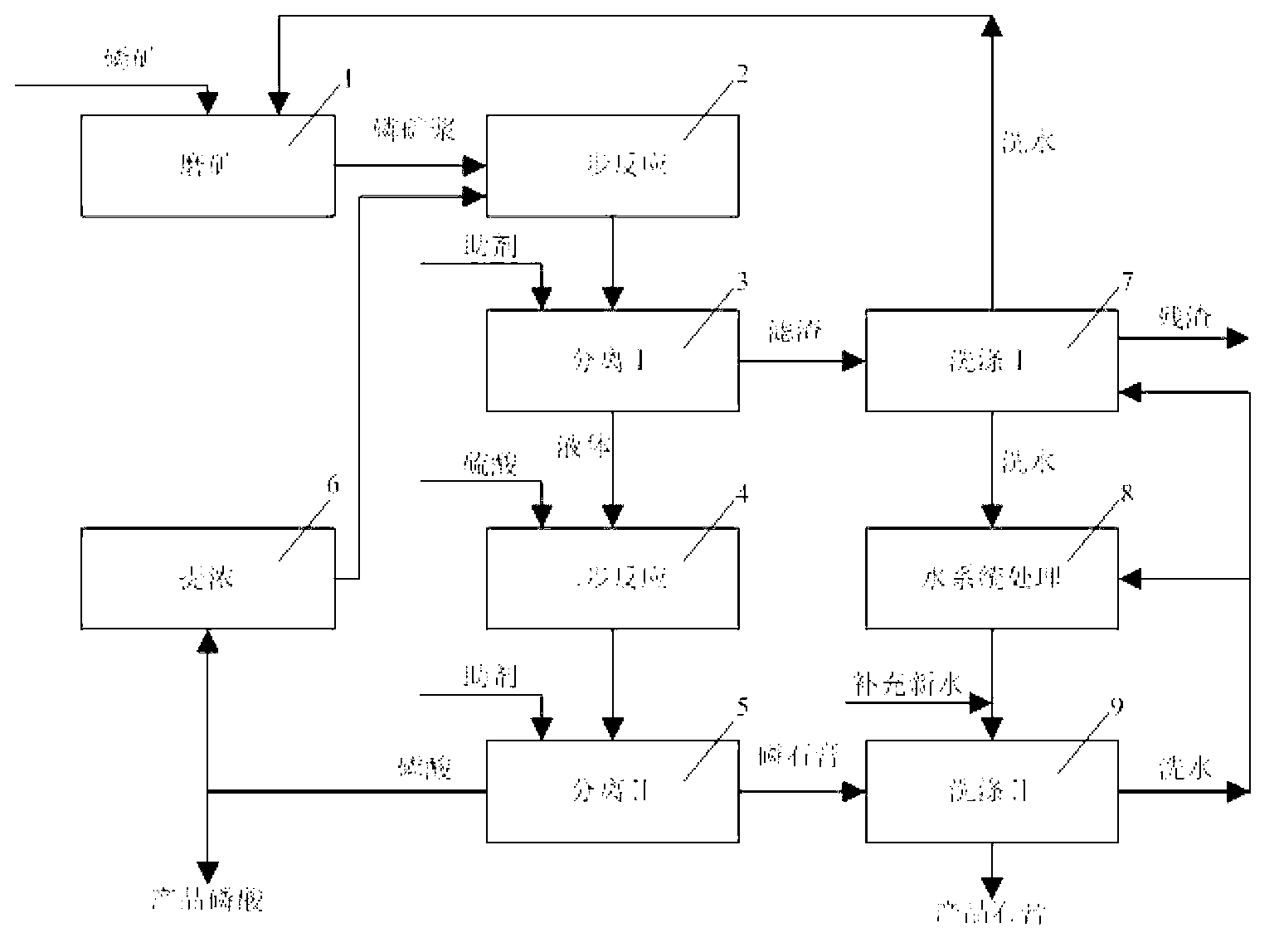Method for producing phosphoric acid by decomposing low-grade phosphate rock with wet-process phosphoric acid
A wet-process phosphoric acid, low-grade technology, applied in the direction of phosphoric acid, phosphorus oxyacids, etc., can solve the problems of high impurity content of acid insoluble matter, difficulty in comprehensive utilization, complex reaction, etc., to simplify the process of phosphorus enrichment and improve the utilization value , The effect of simple process
- Summary
- Abstract
- Description
- Claims
- Application Information
AI Technical Summary
Problems solved by technology
Method used
Image
Examples
Embodiment 1
[0034] A method for producing phosphoric acid by using wet-process phosphoric acid to decompose low-grade phosphate rock comprises the following steps:
[0035] Step 1: Use low-grade phosphate rock (P 2 o 5 =15.12wt%, CaO=39.67wt%, MgO=3.80wt%, Fe 2 o 3 =1.52 wt%, Al 2 o 3 =1.33 wt%) to prepare phosphate rock slurry, and then with phosphoric acid (P 2 o 5=27.63wt%) for a one-step reaction, add additives, react at a temperature of 42°C to 50°C for 3 hours, the liquid-solid ratio in the extraction slurry = 27, add polyacrylamide 20ppm, modified polyacrylamide 10ppm, Polymerized ferrous sulfate 20ppm, the extraction clear liquid and filter residue were obtained through separation I operation, and the extraction rate was 94.8%;
[0036] Step 2: Add 1 part of the extraction clear liquid and 1.20 times the calculated amount of sulfuric acid into a special reactor, sulfuric acid = 96wt%, and carry out a two-step reaction. The temperature is maintained at 80°C to 85°C, and the ...
Embodiment 2
[0039] A method for producing phosphoric acid by using wet-process phosphoric acid to decompose low-grade phosphate rock comprises the following steps:
[0040] Step 1: Use low-grade phosphate rock (P 2 o 5 =18.95wt%, CaO=42.31wt%, MgO=1.52wt%, Fe 2 o 3 =1.47 wt%, Al 2 o 3 =1.28wt%) to prepare phosphate rock slurry, and then with phosphoric acid (P 2 o 5 =35.94wt%) for one-step reaction, adding additives, reacting for 8 hours at a temperature of 35 ° C ~ 42 ° C, the liquid-solid ratio in the extraction slurry = 25, after the reaction is completed, add polyacrylamide 10ppm, polyaluminum chloride 20ppm, through Separation I operation to obtain the extract clear liquid and filter residue, the extraction rate is 96.43%;
[0041] Step 2: Add 1 part of the extraction clear liquid and 1.16 times the calculated amount of sulfuric acid into a special reactor, sulfuric acid = 97wt%, and carry out a two-step reaction. The temperature is maintained at 85°C to 90°C, and the reaction...
Embodiment 3
[0044] A method for producing phosphoric acid by using wet-process phosphoric acid to decompose low-grade phosphate rock comprises the following steps:
[0045] Step 1: Use low-grade phosphate rock (P 2 o 5 =17.24wt%, CaO=40.59wt%, MgO=2.25wt%, Fe 2 o 3 =1.96 wt%, Al 2 o 3 =0.93wt%) to prepare phosphate rock slurry, and then with phosphoric acid (P 2 o 5 =26.59wt%) for a one-step reaction, add additives, react for 6 hours at a temperature of 48 ° C ~ 57 ° C, the liquid-solid ratio in the extraction slurry = 22, after the reaction is completed, add polyacrylamide 2ppm, and obtain the extraction liquid by separation Ⅰ operation Liquid and filter residue, the extraction rate is 95.28%;
[0046] Step 2: Add 1 part of the extraction clear liquid and 1.09 times the calculated amount of sulfuric acid into a special reactor, sulfuric acid = 98wt%, and carry out a two-step reaction. The temperature is maintained at 90°C to 95°C, and the reaction is complete for 5 hours. Add 2pp...
PUM
 Login to View More
Login to View More Abstract
Description
Claims
Application Information
 Login to View More
Login to View More - R&D
- Intellectual Property
- Life Sciences
- Materials
- Tech Scout
- Unparalleled Data Quality
- Higher Quality Content
- 60% Fewer Hallucinations
Browse by: Latest US Patents, China's latest patents, Technical Efficacy Thesaurus, Application Domain, Technology Topic, Popular Technical Reports.
© 2025 PatSnap. All rights reserved.Legal|Privacy policy|Modern Slavery Act Transparency Statement|Sitemap|About US| Contact US: help@patsnap.com

